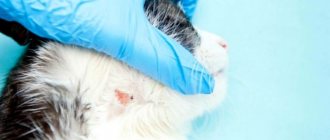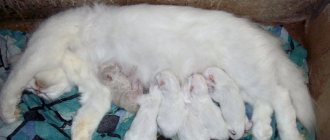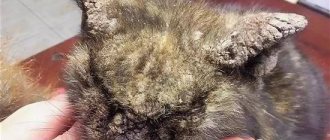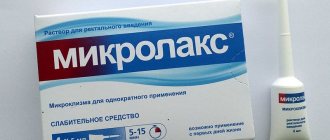Photo: UGC Pets are completely dependent on us, so we are responsible for their health. Ringworm in cats creates a danger not only for the pets themselves, but also for the rest of the household. How many times have we heard our parents’ warnings as children that we shouldn’t touch a barn cat? They scared us of depriving us of other problems. Let's figure out which of this is true and how to help the animal.
What does lichen look like in animals?
In domestic dogs, lichen usually appears on the pet's face, belly, and paws. First, single lesions appear, then the infection spreads throughout the skin. The first changes affect the condition of the coat. Hair becomes brittle and falls out. Bald areas are characterized by a rounded shape with fairly clear boundaries.
Over time, the skin begins to peel off, change color, and inflammatory processes are possible. The pet becomes lethargic and passive. Sometimes the temperature may rise.
Main symptoms of the disease
There is a list of the main signs of lichen in a pet:
- focal hair loss, which tends to increase;
- the appearance of a rash;
- the affected skin turns red and peels;
- itching
Most often, the fungus is localized in the head and neck area, in rare cases it can be the limbs and tail area. It is very important to notice the disease in time and begin treatment, since fungi spread very quickly throughout the body and can infect other areas of the skin.
In the initial stages, ringworm can be confused with other pathologies. Therefore, you cannot do without consulting a veterinarian.
Symptoms of ringworm in pets
First, your pet develops a rash. Then the hairs begin to break and the fur begins to fall out (hence the name “haircut”). Itching causes the animal:
- irritability;
- discomfort;
- anxiety;
- loss of appetite.
Lack of treatment leads to the appearance of “rings” on the skin - round spots with a red border. They may itch and peel, and after a while blisters appear. They are replaced by purulent, weeping wounds. If the disease continues to be ignored, the infection will enter the bloodstream and the fungus can affect the brain. As a result, the pet will die.
How to treat ringworm in animals
If you notice symptoms of ringworm, see your doctor immediately. Treatment is a must! The skin disease will not go away on its own, but the owner may become infected. Therefore, it is important to isolate the animal and provide it with a separate room (a spacious cage).
For the treatment of ringworm in dogs, medications are as follows:
- Vakderm is a vaccine that is used to prevent and treat fungal infections.
- Liverazol is a solution for external use, intended for the treatment of dermatophytoses.
- - a good answer to the question of how to treat lichen in a cat. The ointment kills fungus and harmful bacteria, improves skin regeneration.
- Zoomikol is an anti-lichen spray for cats and dogs that has fungicidal activity and is easy to use.
If there is a risk that the animal will lick the ointment, put a collar on it. Otherwise, in attempts to get rid of the unpleasant odor, it may become poisoned.
What to do if your pet has ringworm
Take precautions:
- During treatment, you should not bathe the animal.
- If there are other pets at home, do not allow them near the sick animal, give it a separate bowl.
- Do not pet your pet and do not allow children to have contact with it.
- Clean the apartment with disinfectants (bleach and hot water).
- Ventilate the room where the sick animal is located.
- Do not walk your dog for long periods of time so as not to infect other pets.
- To disinfect the room, turn on the quartz lamp daily. The sick animal must first be removed from the premises.
Do not kick your pet out of the house or kill it for fear of becoming infected. Consult your doctor to find out how to treat ringworm in your dog and cat. Remember: the infection can be treated!
Causes of infection in cats
It is very easy to become infected with ringworm: just a few minutes of contact with another sick animal or object that has fungal spores is enough.
As mentioned earlier, fungal microorganisms live in the external environment for a long period , which is why the disease often returns again.
Another cause of the disease is poor maintenance of the pet. If a cat does not eat properly and has chronic diseases, it has a weakened immune system, and this is the main reason for infection with ringworm.
Contact with a stray animal will also be dangerous for the cat. In this case, the pet living at home should not have contact with other cats.
If a cat catches mice, this can cause infection, since rodents are carriers of various diseases.
If a cat lives in an apartment and it is unclear where her lichen was discovered, most likely the fungal spores were brought into the room on the sole of a shoe . For this reason, it is necessary to regularly vaccinate your pet and visit the veterinarian once a year.
The main signs of pityriasis versicolor in dogs and cats
The fungus affects the hair follicles, which negatively affects the animal's coat, causing seborrhea and baldness. If the infection gets on the claws, they peel off and collapse.
The spots are yellow-brown in color, the edges resemble lace. They peel off, become covered with bran, and if left untreated, merge with each other. There is not always itching. In winter, the spots may disappear.
How to treat lichen in cats and dogs
Tinea versicolor is a non-contagious disease, so the pet does not need to be isolated. Therapy is similar to the actions for the ringworm form - Vakderm, Yam, Zoomikol. Make sure that the animal does not lick the medicine for lichen, otherwise it may be poisoned.
Pay special attention to immunity - take care of good nutrition, give vitamins and minerals. In summer, walk with the animal in the morning and evening, avoid direct sunlight. If your home has air conditioning, turn it on.
Which breeds are more susceptible
Most often, kittens living in groups are affected, for example, in nurseries or shelters; street animals become infected from each other. Pets can also get sick, having become infected, for example, from a mother cat or even from their owners.
Although shingles can affect all breeds equally, it is believed that kittens of long-haired breeds are most susceptible to the disease. This is due to the fact that under long hair the affected areas may be barely noticeable.
Wetting form
Ringworm is a non-contagious disease better known as eczema. The mechanism of development of the disease is unclear. It is often based on allergies, hormonal imbalances, problems with the nervous system, climate, and ecology.
What does eczema look like in pets?
The disease develops according to the following pattern:
- A small hairless swelling appears on the skin, hot to the touch (either a single or multiple lesions are possible).
- Over time, it turns into a small bubble - a papule, filled with liquid.
- The vesicle gets wet all the time and secretes liquid, sometimes with pus. Due to the source of infection, the fur “sticks together” and looks unsightly.
What to do if your cat or dog has eczema?
If you notice symptoms of eczema in cats and dogs, take zinc ointment for treatment. This is an effective drug for eczema in dogs, which dries wounds, disinfects, and accelerates skin regeneration. You can also use Yam ointment.
Diagnostics
As with other diseases, only a veterinarian can make a diagnosis, confirm or refute your guesses.
The doctor will conduct a comprehensive examination:
- using a Wood's lamp, examine the affected area; the primary method will most likely indicate the presence of lichen - if the diagnosis is confirmed, the fur under the lamp will acquire a green tint;
- examination under a magnifying microscope makes it possible to examine skin scales in detail and see microsporia on the skin or hairs;
- analysis of the scraping for the presence of a nutrient medium - for analysis, a scraping is made from the affected area and sent to the laboratory to identify parasites and fungi.
The first two methods are carried out directly in the doctor’s office, take a few minutes, but do not give a 100% result. The culture is analyzed within 21 days, and its reliability is 100%.
Pink (shingles)
Pityriasis rosea is another skin disease of unknown origin. There are suggestions that it is inherited, has an allergic basis, or is caused by an unknown virus. Most doctors believe that the pathology is harmless, but some veterinarians disagree.
How does skin disease manifest in pets?
Externally, the disease resembles an allergy - small and large pink spots appear. They are flaky in the center, smooth at the edges. The pathology itself is not dangerous, but if bacteria gets into the wound, purulent inflammation is possible.
Treatment method and prognosis
Most cats with ringworm are treated on an outpatient basis, so home treatment, provided it is done correctly, is quite acceptable. It is only important to follow the doctor’s recommendations, because some techniques cannot be applied to small kittens.
The easiest way to treat is to use special shampoos. The kitten is washed with them twice a week for 6 weeks to completely eradicate the infection. You should only use a specialized veterinary anti-fungal shampoo approved for kittens.
If there are only isolated lesions on the animal's body, you can use antifungal ointments or sprays. The kitten is treated in this way for a week and a half, lubricating the wounds twice a day.
At home, lichen is often treated with sulfur ointment, treated with celandine juice, and cauterized with iodine or brilliant green.
With timely treatment and proper care, it is possible to achieve a good result and rid the animal of infection, but procedures must be started as early as possible.
Prevention of lichen in pets
- Get regularly vaccinated against fungus (Vakderm).
- Keep street animals away from your pet.
- Check your pet's skin and coat regularly.
- Treat wounds and scratches with zinc ointment and other antiseptics.
- Maintain good hygiene.
- Treat your pet for fleas and ticks in a timely manner.
- Do not allow your pet to eat from other animals' bowls, especially if they are intended for outdoor dogs and cats.
- Contact your doctor as soon as you notice symptoms of skin diseases - suspicious hair loss, spots.
- Provide your animal with proper nutrition to avoid allergies, weakened immunity, and pathologies associated with metabolic disorders. Do not feed your pet table scraps, do not give fatty, peppery, or other unhealthy foods.
Prevention
Following these rules will help you avoid getting infected and will save your cat:
- Vaccination of an animal against lichen.
- Never pet other people's cats. Teach your children to do this. Stray street cats are especially dangerous.
- Wash your hands with soap: every time you pet your pet; when you come home from the street; after contact with cat accessories: tray, toys, bed.
- Keep your cat away from dirty outdoor shoes and clothing. Wash your shoes when you get home. Clean your hallway regularly.
- Walk your cat in areas where there are no other animals. Avoid contact with stray animals. It is best to keep your pet in an apartment.
- Isolate a cat infected with shingles from other pets and children for the entire course of treatment.
- At the first indirect signs: restlessness, frequent scratching, take the animal to the veterinarian to make or rule out a diagnosis of ringworm.
Important!
Remember that timely detection of pathology and proper treatment will definitely return your pet to health and will not harm the health of your family!
Vaccination against ringworm
Therapeutic and prophylactic vaccinations against lichen in cats are carried out as part of complex therapy for an animal or for healthy animals as a preventive measure. Vaccinations are given to healthy kittens at the age of 3 months.
Therapeutic vaccination is the most effective modern way to get rid of fungal infections of the skin and fur of cats. Injections are given 2-3 times with an interval of 10-14 days.
Vaccines used in veterinary medicine:
- Polivac TM is a highly effective vaccine based on 8 types of strains of weakened fungi (trichophytin, microsporum). The effect of the vaccine lasts 12-14 months. To develop lasting immunity, a second vaccination is carried out 14 days after the first. Vaccination of healthy cats does not cause complications. After a year, revaccination is carried out.
- Vakderm-F is a drug based on non-living spores of ringworm. The injection therapy product is used simultaneously with topical medications (ointments, sprays). To completely cure an animal, 2-3 injections are enough. For preventive purposes, it is used to vaccinate kittens from 2 months of age and healthy adult animals. The effect of the vaccination occurs after 25-30 days. Vaccination is carried out twice with an interval of 1014 days.
- Microderm is a therapeutic injection veterinary drug with high effectiveness against ringworm. To achieve the result, the medicine is administered to the cat twice with an interval of 10-15 days. The product is characterized by low toxicity. Suitable for preventive immunization.
Important!
Injections against lichen cannot be used in the treatment of pregnant and lactating cats, animals with hyperthermia.
Your child has microsporia
To children, the world can seem like one big playground full of adventure. But their desire to play in the ground, pet animals, touch other people's things can lead to infection with various infectious and parasitic skin diseases. Children are especially susceptible to this because their immune systems are not yet fully developed. Summer, holidays, children's holidays in camps, outside the city, lead to a seasonal rise in these diseases. Currently, one of the common skin infections is microsporia. Microsporia affects mainly children of preschool and school age, less often adults. Microsporia is caused by a fungus that gets on children's skin called Microsporum. The fungus is very stable in the external environment. In hair, skin flakes, wool, dust, it retains the ability to infect for several years.
How can your child become infected?
Infection occurs through direct contact with a sick animal (cats, kittens, less often dogs), or objects infected with hair or scales (combs, hats). It is possible to transmit microsporia from sick family members, but this happens less frequently. There have been cases of children becoming infected after playing in the sandbox. However, if you follow the rules of personal hygiene, even if the pathogen spores come into contact with the skin, the disease can be avoided.
How does the disease manifest in a child?
After an incubation period of 5-7 days on average, foci of infection appear on smooth skin or scalp. Microsporia can appear on any part of the skin, but more often on exposed parts of the body. In mild forms of the disease, round lesions form on the skin, clearly defined, covered with scaly nodules and blisters along the periphery. They often form bizarre shapes, like a “ring within a ring”. At the same time, vellus hair may be affected, which complicates the treatment of the disease. The number of lesions ranges from single to several dozen. Size from 0.5 to 3 cm. When the scalp is affected, 1-2 large lesions are formed, round in shape, with clear boundaries and abundant pityriasis-like peeling. The hair breaks off at a height of 6-8 mm above the skin level (hence the name of the disease - ringworm), because the hair in the lesion appears to be trimmed. There may be slight itching in the affected area. The general condition of children is usually not disturbed. With a decrease in immunity, a child may experience complicated forms of microsporia - infiltrative and suppurative forms. The infiltrative form is characterized by the development of severe inflammation in the lesion. The suppurative form is characterized by the formation of dense foci, round in shape, consisting of deep abscesses (cavities filled with pus). Nearby lymph nodes increase in size. The child's general condition may worsen and the temperature may rise. If a child has suffered microsporia in a mild form, then no traces of the disease remain on the skin or scalp. After a complicated form of microsporia, scars may remain on the skin, and focal baldness may remain on the scalp.
Before treatment, visit a doctor.
If a suspicious rash appears on a child’s skin or scalp, consult a dermatologist without first lubricating the affected areas, as this may complicate diagnosis. Correct diagnosis is half the success in treatment. Skin lesions with microsporia can be confused with other types of lichen, psoriasis, eczema, and hair loss may not be caused by a fungal infection. The diagnosis of microsporia is established on the basis of external signs and must be confirmed by microscopic examination and isolation of the pathogen (growing on a nutrient medium). An important diagnostic criterion will be the greenish glow of the affected hair in the rays of an ultraviolet quartz lamp. A similar study is also used in veterinary medicine, so if you have any doubts about the health of your furry pet, take him to the doctor too, but to a veterinarian. As in children, ringworm in pets (dogs, cats, etc.) can appear as patches of hair loss and skin inflammation. However, many animals infected with microsporia have no symptoms and appear completely healthy and safe. This phenomenon is called colonization.
How to cure microsporia or ringworm in a child?
If the doctor confirms that your child has microsporia, he will be able to prescribe you the correct treatment, without which the disease can take a very long time to develop, can cause complications and can spread to other people. Uncomplicated, single lesions on the skin, without damage to vellus hair, can be treated on an outpatient basis, using only external antifungal agents. During treatment, you should not bathe your child in the bath; wash only in the shower, trying to avoid areas with rashes and using antifungal shampoo for washing. Be sure to provide your child with individual bath and bedding items, and iron clothes with a hot iron after washing. Disinfect all toys with an available antiseptic or boiling water.
Numerous foci of microsporia on smooth skin, with damage to vellus hair, damage to the scalp, and complicated forms are an indication for treating a child in a hospital. In addition to external therapy, systemic antifungal drugs are used for treatment. The dose and frequency of taking systemic antimycotics is prescribed by the doctor, taking into account the child’s weight, his general condition, and the manifestations of the disease. How do you know if treatment for ringworm is helping?
In order to determine how the treatment is going, it is necessary to take control tests from the lesions for fungi.
If the tests show that there are no living fungi in the scrapings, this will mean that the treatment was effective.
Typically, the number of fungal spores in the skin and hair is significantly reduced 2 weeks after the start of treatment. The complete disappearance of fungi occurs later. Sometimes, despite active treatment, the release of fungal spores can continue for several months.
If tests show that, despite treatment, fungi are still present in the skin tissues, the doctor may advise either prolonging treatment, prescribing you other antifungal medications, or increasing the dosage of the drug.
Is there any other way to quickly cure ringworm?
Unfortunately, there are no faster and easier methods for treating ringworm.
Can ringworm go away without treatment?
There are cases when ringworm went away on its own. However, more often than not, it does not go away without treatment and spreads to other areas of the skin.
In a child with ringworm, if left untreated, the disease may persist into adulthood.
Can ringworm reoccur?
The human body is not able to develop immunity against the fungi that cause ringworm, so both adults and children can develop the disease again if they become infected with the fungi again.
Ringworm can also recur if treatment is not completed and if viable fungal spores remain in the skin tissue and hair.
Is there a (vaccine) shot for ringworm?
Unfortunately, an effective vaccine against ringworm in humans has not yet been developed.
Carefully following your doctor’s recommendations will help you quickly cope with the disease, and following preventive measures will prevent infection.
How to prevent infection with microsporia?
Considering that the main source of microsporia infection are stray animals, parents, and caregivers. teachers should explain to children that they should not pet or play with stray cats and dogs. To prevent microsporia, you must follow the following rules:
Keep children's hands, body, and hair clean. Do not allow children to wear other people's things, hats, or use other people's combs. Make sure that children wash their hands thoroughly after playing outside, after contact with pets, especially if they are walking outside, and do not take them to bed. Under no circumstances should you play with homeless animals. If you decide to bring a cat or dog into your home, you should definitely check them with a veterinarian. Do not throw sick cats and dogs outside. This contributes to the spread of the disease among animals and can become a source of infection for children. Be carefull.
Ringworm tablets for cats
4:1445
Once the infection with lichen is confirmed and the generalized form is diagnosed, the following medications are prescribed:
4:1673
- Griseofulvin. These are tablets that suppress fungi and help the animal’s body quickly replace affected tissues with new ones. The drug is often used in combination with ointments for lichen, combined with rubbing in iodine and alcohol. It is more convenient to mix the medicine into the cat's food.
- Itraconazole A medicine that suppresses the vital activity of many types of fungi. After use, it is absorbed into all organs and tissues and remains in the body for up to 4 weeks after completion of the course. Since Itraconazole has a toxic effect, the dosage is selected only by a veterinarian.
4:1010
Ringworm vaccine for cats
3:1511
To treat animals, including those with trichophytosis, antifungal vaccines are used, which aggravate the infection and promote the rapid removal of crusts from the surface of microtic lesions. Vaccinations are contraindicated for pregnant and lactating cats and kittens under 2 months of age. Before giving the injection, deworming must be done 10 days before (even for a kitten). Vaccine prices are affordable, since many are produced in Russia. Popular drugs that attack fungi in a short time:
3:908
- Vakderm;
- Polivac;
- Microderm;
- immunostimulants Ribotan, Anandin.
3:1044
Antifungal medicine for ringworm for cats
4:1107
In addition to the medications described above, in case of a generalized form of the disease, cats can be prescribed the drug Ketoconazole. This is a synthetic medicine from the imidazole group. Give the animal 5-10 mg per 1 kg of body weight every 12 hours. The minimum duration of treatment is 1 week. The medicine can cause serious complications, so it is prescribed in advanced cases. Another antifungal medicine that works well is Fluconazole. Treatment for each pet is selected individually and depends on the effect it gives.
4:2075 4:4
5:513
What to do at home
At home, the kitten must be isolated from other animals and from children, since lichen is easily transmitted to humans. You will have to wear gloves to treat wounds and bathe him, wash your hands especially often, and treat the room with antiseptics.
You should not allow your pet into bed; its bed must be frequently disinfected or the bedding changed, since fungal spores remain alive for a long time and can become a source of re-infection.
The kitten needs to be well fed and kept warm. He will have to wear an “Elizabethan collar” around his neck to prevent him from licking off medications, most of them toxic, or from scratching itchy wounds.










